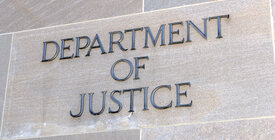Retreat from Crime and Violence Prevention
Some of the most troubling cuts were to programs specifically designed to prevent violent crime. This includes the defunding of successful initiatives to develop plans for reducing violent crime and bolster partnerships among law enforcement agencies, community groups, and researchers. These programs have historically enjoyed strong bipartisan support from politicians, community leaders, and law enforcement.
Law Enforcement Partnerships
For example, the Justice Department cut $3.5 million from Project Safe Neighborhood, a successful national crime-reduction initiative launched in 2001 under President George W. Bush. The program brings together law enforcement officials, community stakeholders, and researchers to develop effective crime-reduction strategies customized to address the most urgent violent crime problems in each federal judicial district. It has been frequently touted as a signature crime-reduction strategy (including by the first Trump administration). April’s cuts targeted training and technical assistance for Project Safe Neighborhood, which helps implement programs and share expertise across jurisdictions. The DOJ now plans to reshape the initiative to focus on immigration enforcement and combating human and drug trafficking, doubling down on debunked myths incorrectly linking immigration and crime.
The department also reduced funding for the Public Safety Partnership, piloted just over a decade ago and endorsed by the first Trump administration. This initiative provides department-wide training, technical assistance, and other resources to support specialized, data-driven plans to address the unique factors driving violent crime in more than 67 local jurisdictions. Participating jurisdictions have reported impressive progress in crime reduction: Indianapolis saw a 30 percent increase in homicide clearance rates. Oxford, Alabama, reported a 61 percent drop in violent crime.
Rural Communities
Communities of all types, from big cities to suburbs to rural areas, saw crime increase in the early 2020s. Yet the Rural Violent Crime Reduction Initiative lost more than $13 million in this round of cuts. It was launched in 2021 in response to the violent crime challenges facing rural communities, often amidst budget and staffing constraints in geographically dispersed areas. The initiative assists rural law enforcement agencies in expanding victim services and developing, implementing, and measuring strategies to reduce violent crime. It also provides subsidiary grants directly to local law enforcement.
The stark decline in federal funding threatens programs in rural communities already strapped for resources. For example, the Union County, Oregon, district attorney’s office relied on funds from the initiative to hire an investigator focused on sexual assault, intimate partner violence, child abuse, and violent crimes involving seniors and adults with disabilities. The investigator also worked with government agencies and social services entities to enhance services for victims. The Lyons Police Department in Kansas lost funding for a recently opened county child advocacy center that conducted specialized interviews with child sex abuse victims.
The Shawano, Wisconsin, police department funded a detective position dedicated exclusively to investigating violent crime and narcotics. The additional capacity to enhance crime-prevention efforts, patrols, and community partnerships resulted in increased narcotics seizures that removed dangerous illegal substances from the community.
Similarly, Vernon County, Wisconsin, used funding from the Rural Violent Crime Reduction Initiative to support its Help End Abuse Response Team program that promotes coordination between community volunteers and law enforcement in responding to domestic violence incidents. The funding also provided support for victim services, training for local sexual assault nurse examiners so victims would no longer need to travel for examinations, and resources for local clinicians to run batterers groups to reduce cycles of violence.
Community-Based Strategies
Massive cuts totaling $169 million targeted community-based safety grants, the majority of which supported community violence intervention programs. Such initiatives are a relatively new but promising way to reduce violence, relying on community leaders to identify, respond to, and de-escalate scenarios that might otherwise turn violent. Examples include “violence interrupters,” in which outreach workers intervene to personally defuse conflicts, and hospital-based programs that support victims while breaking cycles of retribution. They have also benefited from significant government investment. Aside from DOJ grantmaking, the Biden administration used the American Rescue Plan to direct funds to build and scale new local-level responses to crime. The Bipartisan Safer Communities Act contributed further funding.
The DOJ’s cuts reverse that process while undermining the economies of scale that community violence intervention groups need to survive. For one, federal funding helps build the capacity of the community violence prevention field, facilitating knowledge sharing and the dissemination of best practices and professional expertise. Some small but promising organizations, for example, may lack the staffing or resources to apply for federal money. Grants to intermediary organizations can bridge that gap, as they can identify and sub-grant to grassroots community organizations. In other cases, umbrella groups can coordinate research evaluations, trainings, and technical assistance. Chicago’s Metropolitan Family Services, which operates a “training center” for professionals involved in community violence intervention, is an example of an organization that provides both direct services and hands-on assistance to the field. The current administration writes off these umbrella groups as inefficient go-betweens — a misunderstanding that ignores how the field benefits from networked, complementary organizations.
In another case, Newark, New Jersey, now faces cuts to its network of nonprofits, researchers, and government partners focused on building safer communities. The Newark Community Street team employs people with deep knowledge of neighborhood-level relationships to respond to and break up potentially dangerous interactions and counsel people at risk of violence. Federal funding totaling $5 million across four grants allowed the team to expand its work into different parts of the city, follow key networks of people, and embed outreach workers in local schools to counsel at-risk young people.
April’s cuts forced Newark Community Street to lay off roughly a dozen people, functionally ending those expansions. Fewer staff means fewer response teams, degrading the group’s ability to safely respond to as many high-risk incidents as may call for its expertise. It also means the remaining staff lost access to departed staffers’ personal networks.




